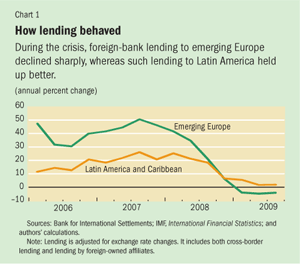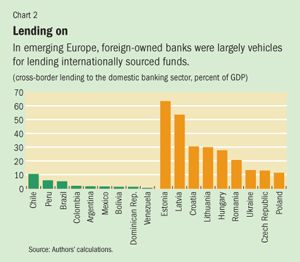A Tale of Two Regions
Finance & Development, March 2010, Volume 47, Number 1
Jorge Ivan Canales-Kriljenko, Brahima Coulibaly, and Herman Kamil
Foreign-bank lending to emerging markets during the global crisis differed from continent to continent
LENDING by foreign banks is an important part of international capital flows to emerging markets and a defining feature of financial globalization. In the years preceding the recent global crisis, foreign-bank lending to emerging economies expanded rapidly—whether directly from foreign-bank headquarters (cross border) or through affiliates operating in host countries. In many countries, especially in Latin America and emerging Europe, lending by foreign banks became a significant source of funding for households and corporations. Although it had its pros and cons, on balance the presence of foreign-owned banks was generally believed to have enhanced competition and aided overall financial stability.
During the global credit crunch, however, foreign banks were potential vehicles for spreading the crisis from advanced economies to emerging markets. In particular, the international credit crunch raised concerns that, as had happened in previous crises, these bank flows would come to a sudden stop, disrupting macroeconomic stability and undermining economic recovery efforts.

Yet this tale unfolded differently in Latin America than it did in emerging Europe. In Latin America there was no sudden stop. Foreign-bank lending continued to grow, albeit at a more modest pace. By end-March 2010, total outstanding claims by foreign banks in Latin America had increased slightly compared with end-September 2008, when the Wall Street investment firm Lehman Brothers collapsed and sent world financial markets into turmoil. This contrasts with the behavior of foreign-bank-lending growth to emerging Europe, which declined sharply with the onset of the global credit crunch in mid-2007 and turned negative by early 2009 (see Chart 1). What can explain the different behavior in foreign-bank lending between these two regions?

A key difference is the role foreign banks played in sustaining rapid domestic credit growth during the precrisis period. In emerging Europe, globally operating banks from western Europe (mostly from Austria, Belgium, Italy, and Sweden) fueled a credit boom in most countries. These banks transferred large amounts of capital to their subsidiaries, which in turn lent these funds domestically (see Chart 2). As a result of the aggressive expansion strategy of western banks, most of the domestic banking systems in emerging Europe became dominated by global banks—in a number of countries their market share skyrocketed to over 90 percent. In Latin America, on the other hand, the pace of foreign banks’ credit growth was more moderate, and subsidiaries’ lending was much less reliant on external funding from parent banks in advanced economies (most of which were from Spain, the United Kingdom, and the United States). At the same time, the degree of foreign ownership of the banking sector was in general lower, although in some countries, particularly Mexico and El Salvador, there was a large presence of foreign-bank affiliates.
By the time the financial crisis erupted, emerging Europe was experiencing greater financial vulnerability than Latin America. Across emerging Europe, credit had grown at a faster pace, external debt was higher, and current account balances were showing large deficits. When the credit boom went bust after the collapse of Lehman Brothers, economic activity in emerging Europe was hit harder than in any other emerging market region, leading to severe recessions. The slowdown in private credit likely reflected declines in both credit demand and credit supply. Thus, the different dynamics of foreign banks’ lending to emerging Europe (faster credit expansion followed by a deeper crunch) could be seen as part of a broader story of wider financial swings in emerging Europe than in Latin America.
Differences in foreign-bank strategies
The faster credit deceleration in emerging Europe than in Latin America could also be rooted in the different business models and expansion strategies of international banking groups in both regions. Two differences are worth highlighting (see IMF, 2009).
In Latin America, local affiliates were funded primarily through domestic deposits (which were relatively stable during the crisis), rather than through loans or capital transfers from parent banks. Lending by foreign banks’ local affiliates in Latin America was thus less vulnerable to sudden withdrawal of short-term external funding and contagion from the international liquidity squeeze, and continued to expand even amid the global turmoil. In emerging Europe, on the other hand, lending by foreign-owned banks depended to a great extent on parent banks in western Europe, which experienced significant financial stress and faced tight interbank liquidity conditions during the crisis. This prompted a cutback in funding to local affiliates, which in turn reduced lending in host markets.
The currency makeup of foreign-bank lending appears to be different as well. In Latin America, 60 percent of foreign-bank lending is denominated in local currency. Domestic financial dollarization is low in most of the large Latin American countries and has been systematically declining in the more dollarized ones over the past decade. In emerging Europe, 60 percent of foreign-bank lending is denominated in foreign currency. Given that local subsidiaries relied on foreign-currency funding from abroad and needed to keep their assets and liabilities currency-matched, foreign banks lent mostly in euros rather than in local currency. Lending denominated in foreign currency has additional risks stemming from swings in exchange rates. For example, domestic-currency depreciation could push up the cost of borrowing or increase expected defaults when borrowers have currency mismatches, leading to a stronger credit retrenchment.
Empirical evidence suggests that these two factors may have been at play during the recent global crisis. Kamil and Rai (2010) explore in detail the importance of funding sources and the loans’ currency denomination in terms of the resilience of foreign-bank lending to external shocks across Latin American countries. They also assess the effects of three factors that shaped the recent global financial turmoil—tight interbank liquidity, mounting pressure on major banks’ capital positions in advanced economies, and more restrictive lending standards in developed economies’ banking systems. After controlling for other elements that drive foreign-bank financing, the authors found that the propagation of these global financial shocks was significantly more muted in Latin American countries, where foreign banks funded themselves through domestic deposits rather than through parent banks or wholesale markets, and where much of the lending was denominated in local currency.
Mitigating volatility
Recent experience of foreign-bank lending to Latin America and emerging Europe suggests a few tentative lessons for mitigating volatility and is relevant to policy discussions of the costs and benefits of opening the domestic banking sector to foreign competition. Foreign-bank lending funded by domestic deposits and denominated in local currency is likely to be more resistant to external financial shocks and indeed, in Latin America, acted as a firewall against the transmission of global financial shocks. This is a plausible explanation for why Latin American countries have not been hit as hard as other emerging markets by global deleveraging and the pullback in foreign-bank lending.
References
International Monetary Fund (IMF), 2009, Regional Economic Outlook: Western Hemisphere (Washington, May).-
Kamil, Herman, and Kulwant Rai, 2010, “The Effect of the Global Credit Crunch on Foreign Banks’ Lending to Emerging Markets: Why Did Latin America Fare Better?” (unpublished; Washington: International Monetary Fund).


